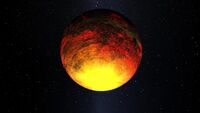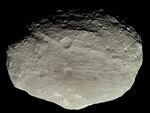Astronomy:Kepler-10
| Observation data Equinox J2000.0]] (ICRS) | |
|---|---|
| Constellation | Draco |
| Right ascension | 19h 02m 43.06139s[1] |
| Declination | +50° 14′ 28.7016″[1] |
| Apparent magnitude (V) | 11.157[2] |
| Characteristics | |
| Spectral type | G2V[3] |
| Astrometry | |
| Radial velocity (Rv) | −98.44±0.24[1] km/s |
| Proper motion (μ) | RA: −18.483[1] mas/yr Dec.: 41.382[1] mas/yr |
| Parallax (π) | 5.3698 ± 0.0103[1] mas |
| Distance | 607 ± 1 ly (186.2 ± 0.4 pc) |
| Details | |
| Mass | 0.910±0.021[2] M☉ |
| Radius | 1.065±0.009[2] R☉ |
| Temperature | 5708±28[2] K |
| Metallicity [Fe/H] | −0.15±0.04[4] dex |
| Age | 10.6+1.5 −1.3[2] Gyr |
| Other designations | |
| Database references | |
| SIMBAD | data |
| KIC | data |
Kepler-10, formerly known as KOI-72, is a Sun-like star in the constellation of Draco that lies 607 light-years (186 parsecs) from Earth.[5][6] Kepler-10 was targeted by NASA's Kepler spacecraft, as it was seen as the first star identified by the Kepler mission that could be a possible host to a small, transiting exoplanet.[7] The star is slightly less massive, slightly larger, and slightly cooler than the Sun; at an estimated 11.9 billion years in age, Kepler-10 is almost 2.6 times the age of the Sun.[5]
Kepler-10 is host to a planetary system made up of at least three planets. Kepler-10b, the first undeniably rocky planet,[7] was discovered in its orbit after eight months of observation and announced on January 10, 2011. The planet orbits its star closely, completing an orbit every 0.8 days,[8] and has a density similar to that of iron.[7] The second planet, Kepler-10c, was confirmed on May 23, 2011, based on follow-up observations by the Spitzer Space Telescope. The data shows it has an orbital period of 42.3 days and has a radius more than double that of Earth, but it was initially thought to have a higher density, making it the largest and most massive rocky planet discovered as of June 2014.[2][9][10] However, refined mass measurements have shown it to be a more typical volatile-rich planet.[11] A third planet, Kepler-10d, was discovered in 2023 by radial velocity observations.[4]
Nomenclature and history
Kepler-10 was named because it was the tenth planetary system observed by the Kepler spacecraft, a NASA satellite designed to search for Earth-like planets that transit, or cross in front of, their host stars with respect to Earth. The transit slightly dims the host star; this periodic dimming effect is then noted by Kepler.[12] After eight months of observation ranging from May 2009 to January 2010, the Kepler team established Kepler-10b as the first rocky exoplanet discovered by the Kepler satellite. Kepler-10 was the first Kepler-targeted star suspected of having a small planet in orbit. Because of that, verifying Kepler's discovery was prioritized by telescopes at the W.M. Keck Observatory in Hawaii. The discovery was successfully verified.[7] Although there had been many potentially rocky exoplanets discovered in the past, Kepler-10b was the first definitively rocky planet to have been discovered.[13]
The discovery of Kepler-10b was announced to the public at a winter meeting of the American Astronomical Society on January 10, 2011 in Seattle.[13] On May 23, 2011, the existence of Kepler-10c was confirmed at the 218th AAS meeting in Boston.[14]
Characteristics
Kepler-10 is a G-type star, like the Sun. With a mass of 0.895 (± 0.06) Msun and a radius of 1.056 (± 0.021) Rsun, the star is approximately 10% less massive than and 5% wider than the Sun. The metallicity of Kepler-10, as measured in [Fe/H] (the amount of iron in the star), is -0.15 (± 0.04); this means that Kepler-10 is about 70% as metal-rich as the Sun. Metallicity tends to play a large role in the formation of planets, determining if they form, and what kind of planet they will form.[15] In addition, Kepler-10 is estimated to be 11.9 billion years old and to have an effective temperature of 5627 (± 44) K;[5] To compare, the Sun is younger and hotter, with an age of 4.6 billion years[16] and an effective temperature of 5778 K.[17]
Kepler-10 is located at a distance of 186 parsecs from the Earth, which equates to approximately 607 light years. Also, Kepler-10's apparent magnitude, or brightness as seen from Earth, is 10.96; it therefore cannot be seen with the naked eye.[5]
Planetary system
Per the usual exoplanet nomenclature, the first planet discovered to be orbiting Kepler-10 is called Kepler-10b. Announced in 2011, it was the first definitely rocky planet identified outside the Solar system. The planet has a mass that is 3.33±0.49 times that of Earth's and a radius that is 1.47+0.03−0.02 times that of Earth.[2] The planet orbits Kepler-10 at a distance of 0.01684 AU every 0.8375 days; this can be compared to the orbit and orbital period of planet Mercury, which circles the Sun at a distance of 0.3871 AU every 87.97 days.[18] Because the planet orbits so closely to its star, its eccentricity is virtually zero. It, thus, has an extremely circular orbit.[8]
Kepler-10c[9] was also discovered by NASA's Kepler Mission,[19] the second exoplanet found to orbit Kepler-10. Radial-velocity measurements of the body initially suggested that it has a mass of 17.2±1.9 Earth masses and a radius of 2.35 Earth radii, which would have made it the largest known rocky planet (As of 2014). Kepler-10c would orbit Kepler-10 at a distance of 0.24 AU every 45.29 days.[2] However, in July 2017, more careful analysis of HARPS-N and HIRES data showed that Kepler-10c was much less massive than originally thought, instead around 7.37+1.32
−1.19 M⊕ with a mean density of 3.14 g/cm3. Instead of a primarily rocky composition, the more accurately determined mass of Kepler-10c suggests a world made almost entirely of volatiles, mainly water.[11]
A candidate third planet with an orbital period of about 102 days, given the provisional designation KOI-72.X, was identified in 2016 based on transit-timing variations.[20][11] In 2023, the presence of a third planet, Kepler-10d, was confirmed by radial velocity observations. It has an orbital period of 151 days and a minimum mass about 13 times that of Earth.[4]
| Companion (in order from star) |
Mass | Semimajor axis (AU) |
Orbital period (days) |
Eccentricity | Inclination | Radius |
|---|---|---|---|---|---|---|
| b | 3.26±0.30 M⊕ | 0.01685±0.00013 | 0.8374907±0.0000002 | 0 | 84.8+3.2 −3.9° |
1.470+0.030 −0.020 R⊕ |
| c | 11.4±1.3 M⊕ | 0.2410±0.0019 | 45.294301±0.000048 | 0.130±0.050 | 89.623±0.011° | 2.355±0.022 R⊕ |
| d | ≥12.68±2.24 M⊕ | 0.5379±0.0044 | 151.04±0.45 | <0.26 | — | — |
See also
- Kepler Mission
- List of exoplanets
References
- ↑ 1.0 1.1 1.2 1.3 1.4 Vallenari, A. et al. (2022). "Gaia Data Release 3. Summary of the content and survey properties". Astronomy & Astrophysics. doi:10.1051/0004-6361/202243940 Gaia DR3 record for this source at VizieR.
- ↑ 2.0 2.1 2.2 2.3 2.4 2.5 2.6 2.7 Dumusque, Xavier; Bonomo, Aldo S.; Haywood, Raphaëlle D.; Malavolta, Luca; Ségransan, Damien; Buchhave, Lars A.; Cameron, Andrew Collier; Latham, David W. et al. (2014). "The Kepler-10 Planetary System Revisited by Harps-N: A Hot Rocky World and a Solid Neptune-Mass Planet". The Astrophysical Journal 789 (2): 154. doi:10.1088/0004-637X/789/2/154. Bibcode: 2014ApJ...789..154D.
- ↑ 3.0 3.1 "Kepler-10". SIMBAD. Centre de données astronomiques de Strasbourg. http://simbad.u-strasbg.fr/simbad/sim-basic?Ident=Kepler-10.
- ↑ 4.0 4.1 4.2 4.3 Bonomo, A. S. et al. (April 2023). "Cold Jupiters and improved masses in 38 Kepler and K2 small-planet systems from 3661 high-precision HARPS-N radial velocities. No excess of cold Jupiters in small-planet systems". Astronomy & Astrophysics. doi:10.1051/0004-6361/202346211.
- ↑ 5.0 5.1 5.2 5.3 "Notes for star Kepler-10". Extrasolar Planets Encyclopaedia. 2011. http://www.exoplanet.eu/star.php?st=Kepler-10.
- ↑ "Kepler-10 Stellar Family Portrait". https://exoplanets.nasa.gov/resources/17/kepler-10-stellar-family-portrait/.
- ↑ 7.0 7.1 7.2 7.3 "NASA'S Kepler Mission Discovers Its First Rocky Planet". Ames Research Center. NASA. 10 January 2011. http://www.kepler.nasa.gov/news/nasakeplernews/index.cfm?FuseAction=ShowNews&NewsID=94.
- ↑ 8.0 8.1 "Summary Table of Kepler Discoveries". NASA. 2011. http://kepler.nasa.gov/Mission/discoveries/.
- ↑ 9.0 9.1 Fressin, François et al. (2011). "Kepler-10c, A 2.2-Earth Radius Transiting Planet In A Multiple System". The Astrophysical Journal Supplement Series 197 (1): 5. doi:10.1088/0067-0049/197/1/5. Bibcode: 2011ApJS..197....5F.
- ↑ Clavin, Whitney (June 2, 2014). "Astronomers Confounded By Massive Rocky World". NASA. http://www.jpl.nasa.gov/news/news.php?release=2014-171.
- ↑ 11.0 11.1 11.2 Rajpaul, V. (July 2017), "Pinning down the mass of Kepler-10c: the importance of sampling and model comparison", Monthly Notices of the Royal Astronomical Society 471 (1): L25–L130, doi:10.1093/mnrasl/slx116, Bibcode: 2017MNRAS.471L.125R.
- ↑ "Mission overview". Kepler and K2. NASA. 13 April 2015. https://www.nasa.gov/mission_pages/kepler/overview/index.html.
- ↑ 13.0 13.1 Richard A. Lovett (10 January 2011). "NASA Finds Smallest Earthlike Planet Outside Solar System". National Geographic Society. http://news.nationalgeographic.com/news/2011/01/110110-nasa-kepler-10b-new-planet-found-rocky-science-space/.
- ↑ "Kepler Spacecraft Shows That Smaller Planets Abound". Scientific American. 2011. http://www.scientificamerican.com/article.cfm?id=kepler-planet-census.
- ↑ Henry Bortman (12 October 2004). "Extrasolar Planets: A Matter of Metallicity". Space Daily. http://www.spacedaily.com/news/extrasolar-04zl.html.
- ↑ Fraser Cain (16 September 2008). "How Old is the Sun?". Universe Today. http://www.universetoday.com/18237/how-old-is-the-sun/.
- ↑ Ed Grayzeck. "Sun Fact Sheet". Goddard Space Flight Center. NASA. http://nssdc.gsfc.nasa.gov/planetary/factsheet/sunfact.html.
- ↑ David Williams (17 November 2010). "Mercury Fact Sheet". Goddard Space Flight Center. NASA. http://nssdc.gsfc.nasa.gov/planetary/factsheet/mercuryfact.html.
- ↑ "NASA'S Kepler Mission Discovers Its First Rocky Planet". NASA. 2011-01-10. http://www.nasa.gov/topics/universe/features/rocky_planet.html.
- ↑ Weiss, Lauren M. et al. (March 2016). "Revised Masses and Densities of the Planets around Kepler-10". The Astrophysical Journal 819 (1): 83. doi:10.3847/0004-637X/819/1/83. Bibcode: 2016ApJ...819...83W.
Coordinates: ![]() 19h 02m 43s, +50° 14′ 28.7″
19h 02m 43s, +50° 14′ 28.7″
 |






